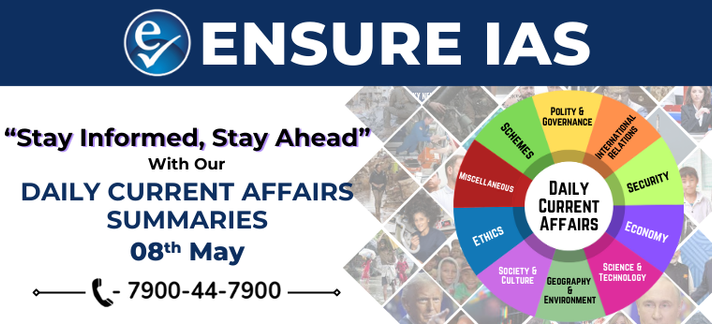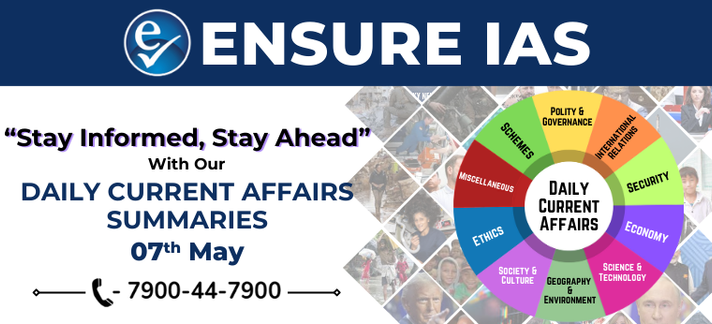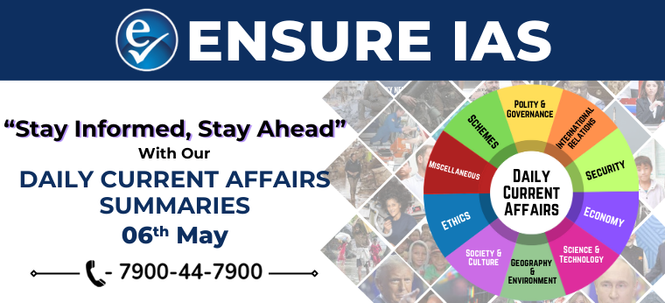- Courses
- GS Full Course 1 Year
- GS Full Course 2 Year
- GS Full Course 3 Year
- GS Full Course Till Selection
- Answer Alpha: Mains 2025 Mentorship
- MEP (Mains Enrichment Programme) Data, Facts
- Essay Target – 150+ Marks
- Online Program
- GS Recorded Course
- Polity
- Geography
- Economy
- Ancient, Medieval and Art & Culture AMAC
- Modern India, Post Independence & World History
- Environment
- Governance
- Science & Technology
- International Relations and Internal Security
- Disaster Management
- Ethics
- NCERT Current Affairs
- Indian Society and Social Issue
- NCERT- Science and Technology
- NCERT - Geography
- NCERT - Ancient History
- NCERT- World History
- NCERT Modern History
- CSAT
- 5 LAYERED ARJUNA Mentorship
- Public Administration Optional
- ABOUT US
- OUR TOPPERS
- TEST SERIES
- FREE STUDY MATERIAL
- VIDEOS
- CONTACT US
Daily Current Affairs Summary 22nd APRIL 2025
Daily Current Affairs Summary 22nd APRIL 2025
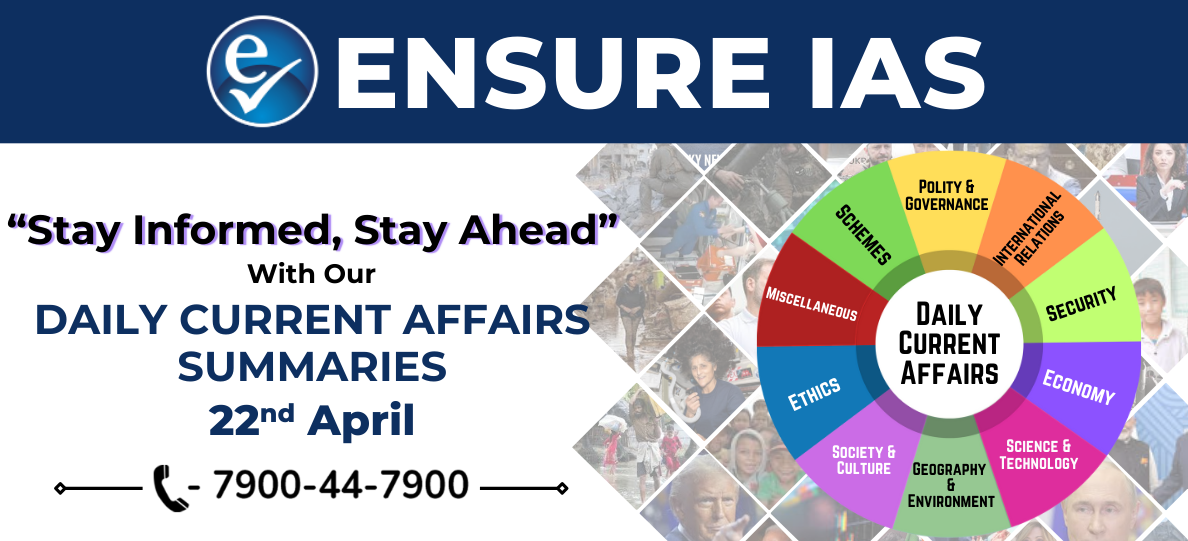
India’s first Fast-Breeder Nuclear Reactor (500 MWe) commissioning by 2026
- India is set to commission its first Fast Breeder Reactor (FBR) with a capacity of 500 MWe by 2026.
- The reactor is located at Kalpakkam, in the state of Tamil Nadu.
- This development marks a significant milestone in Stage-II of India’s three-stage nuclear power programme.
Overview of the Fast Breeder Reactor (FBR)
- The concept of the Prototype Fast Breeder Reactor (PFBR) was initiated in 2003.
- Bharatiya Nabhikiya Vidyut Nigam Limited (BHAVINI) was established to construct and operate the PFBR.
- The Nuclear Power Corporation of India Limited (NPCIL) was responsible for implementing Stage-I of the programme.
Working Mechanism of the FBR
- The FBR uses indigenously produced Uranium-Plutonium Mixed Oxide (MOX) fuel.
- It employs liquid sodium as the coolant for efficient heat transfer.
- The core is surrounded by a Uranium-238 blanket, which undergoes transmutation.
- This transmutation process breeds Plutonium-239, making it a breeder reactor.
Significance and Benefits of the FBR
- It plays a crucial role in initiating Stage-III of India’s nuclear programme.
- Stage-III involves using Thorium-232, a non-fissile material, to produce Uranium-233, a fissile fuel.
- India becomes the second country after Russia to achieve commercial-level FBR technology.
- The reactor contributes to reducing nuclear waste by reusing spent fuel from Stage-I.
- It facilitates the utilization of India's vast thorium reserves, enhancing long-term energy security.
India’s Three-Stage Nuclear Power Programme
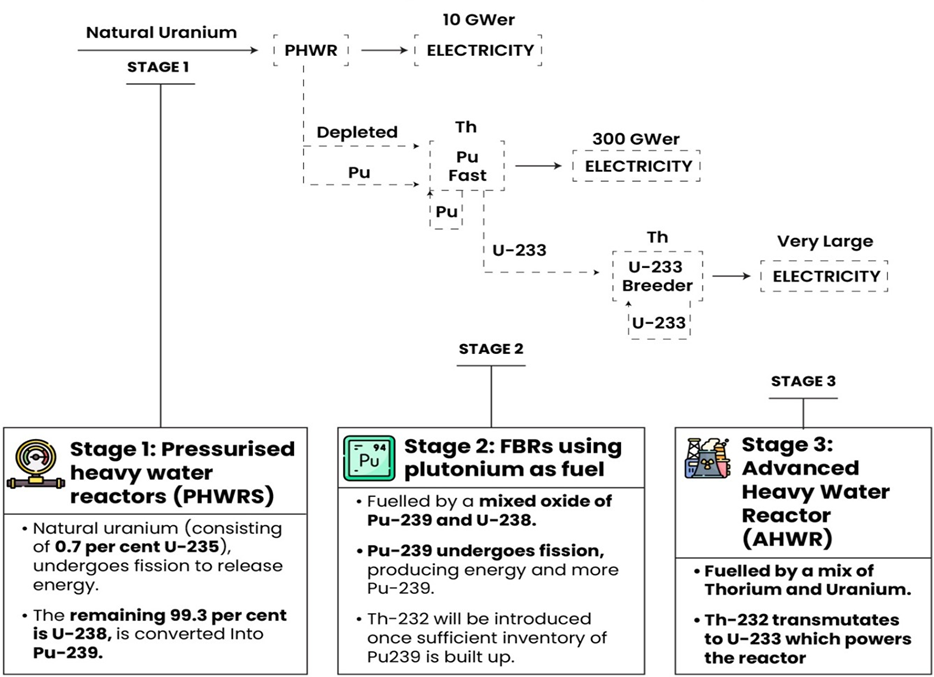
India’s Three-Stage Nuclear Power Programme
- Devised by Dr. Homi J. Bhabha, the father of India’s nuclear programme, in the 1950s.
- The strategy aims to optimize the use of limited uranium and abundant thorium resources.
- Stage-I: Uses Pressurized Heavy Water Reactors (PHWRs) fueled by natural uranium.
- Stage-II: Deploys Fast Breeder Reactors to breed plutonium and initiate thorium conversion.
- Stage-III: Utilizes Uranium-233 bred from Thorium-232 for sustainable nuclear energy.
Climate Change Could Shift Earth’s Poles by Up to 27 Meters
- A recent study warns that ongoing climate change could lead to significant shifts in Earth's geographic poles.
- The geographic poles are the fixed points where Earth’s axis of rotation intersects the planet’s surface.
- The gradual movement of these poles relative to Earth's crust is known as polar motion.
Reasons Behind the Shifting of Earth’s Poles
- Earth's rotation is not perfectly consistent and experiences slight wobbles over time.
- These wobbles are influenced by the redistribution of mass across the planet’s surface.
- Key factors contributing to polar motion include:
- Variations in atmospheric pressure and ocean currents,
- Internal activity like core-mantle interactions,
- And most significantly, the melting of ice sheets and glaciers.
- The study estimates that melting ice and changing ocean mass could displace the poles by 12 to 27 meters by the year 2100.
- The primary contributors to this shift are ice losses from Greenland and Antarctica, along with smaller glaciers worldwide.
Potential Impacts of Shifting Poles
- Navigation and Satellite Issues: Changes in pole positions can disrupt systems relying on Earth’s rotation, such as GPS and space telescopes.
- Lengthening of Days: As melting ice redistributes mass from the poles toward the equator, Earth’s shape becomes slightly more flattened.
- This altered mass distribution slows down Earth’s rotation, making days marginally longer.
- Since the year 2000, Earth’s days have been increasing in length by 1.33 milliseconds per century, a rate faster than in previous decades.
South African Cheetahs Released in Gandhi Sagar Sanctuary, Madhya Pradesh
- Two cheetahs have been translocated to Gandhi Sagar Sanctuary in Mandsaur district, Madhya Pradesh.
- These cheetahs were initially brought to India from South Africa under Project Cheetah in February 2023.
- Their relocation from Kuno National Park aims to diversify habitats and support long-term conservation goals.
Project Cheetah – India’s Historic Wildlife Initiative
- Launched in 2022, Project Cheetah is India’s flagship effort to reintroduce cheetahs after their extinction in 1952.
- The project is led by the National Tiger Conservation Authority (NTCA).
- Wildlife Institute of India (WII) provides technical support to the initiative.
- In 2023, NTCA constituted a Cheetah Project Steering Committee to oversee, monitor, and advise the project's execution.
Legal and Administrative Framework
- NTCA functions as a statutory body under the Ministry of Environment, Forests and Climate Change.
- It was established under the Wildlife (Protection) Act, 1972, as amended in 2006.
- The project is aligned with India’s commitment to restoring ecological balance and species diversity.
Key Objectives of Project Cheetah
- To establish viable breeding populations of cheetahs in secure and historical habitats.
- To use the cheetah as a flagship and umbrella species for restoring open forest and savanna ecosystems.
- To promote eco-development and ecotourism, thereby improving local community livelihoods.
About the Cheetah – The World's Fastest Mammal
- Cheetahs hold the title of the fastest land animal on Earth.
- They are the only large carnivore species declared extinct in India, last seen in 1952.
- Listed under Appendix I of CITES, offering the highest level of international protection.
- Unlike other big cats, cheetahs do not roar; they communicate through chirps and purrs.
Geographical Distribution of Cheetahs
- In Asia, wild cheetahs now survive only in eastern Iran, with reintroduced populations in India.
- In Africa, they thrive in grasslands, scrublands, and open woodlands, mainly in Botswana, Namibia, and South Africa.
Species of Cheetahs and Their Conservation Status
- African Cheetah: Classified as Vulnerable by the IUCN.
- Asiatic Cheetah: Listed as Critically Endangered, with fewer than 50 individuals remaining, all in Iran.
RBI Governor Flags Key Issues in India’s Financial Market Amid Global Volatility
- Financial markets serve as platforms for capital mobilization and trading of financial instruments such as bonds, equities, forex, and derivatives.
- In light of evolving global financial conditions, the RBI Governor has highlighted systemic inefficiencies in India's financial market structure.
Concerns in Specific Segments of India’s Financial Markets
1. Government Securities (G-Secs) Market
- Liquidity concentration exists in a limited set of securities, especially short-term ones.
- Longer maturity G-Secs witness reduced trading activity, creating depth challenges.
- The secondary market is heavily dominated by banks and Primary Dealers, limiting broader participation.
- The Turnover Ratio (annual turnover relative to outstanding stock) remains consistently low.
2. Money Market
- The Call Money Market is experiencing a gradual decline in liquidity.
- This market facilitates overnight borrowing and lending between institutions.
- In the Term Money Market, there is over-reliance on overnight transactions.
- Lack of a developed risk-free term structure hampers effective interest rate benchmarking.
- There are rate asymmetries between instruments such as:
- Call Money Rate,
- Market Repo Rate, and
- Tri-Party Repo Dealing System (TREPS) rate.
- In a tri-party repo, a third-party intermediary manages aspects such as collateral selection, payment, and settlement.
3. Foreign Exchange (FX) Market
- The market shows pricing disparities between large and small clients.
- There are instances of non-compliance with regulatory norms on pricing transparency and market fairness.
4. Derivatives Market
- The market remains small in both absolute size and relative to GDP.
- It suffers from limited product diversity and low trading liquidity.
Way Forward: Reforms and Strategic Initiatives
- Develop a Secured Overnight Rupee Rate (SORR) to act as a benchmark in derivative markets, based on secured overnight lending rates.
- Promote retail participation in the G-Sec market through initiatives like the ‘RBI Retail Direct’ platform.
- Encourage proactive involvement of banks to ensure effective transmission of RBI’s liquidity measures to all segments of the financial system.
NITI Aayog Member Advocates GM Crop Adoption for Edible Oil Self-Sufficiency
- A NITI Aayog member has emphasized the need to adopt Genetically Modified (GM) crops to achieve self-reliance in edible oil production.
- This call comes amid increasing consumption and growing dependence on imports.
Understanding GM Crops
- GM crops are genetically modified organisms with DNA altered through artificial means to enhance desired traits.
- These modifications aim to improve resilience, yield, and pest resistance.
- Transgenic crops, a subset of GMOs, involve introducing genes from another species.
Example: Bt cotton contains a gene from the Bacillus thuringiensis bacterium for pest resistance.
Status of GM Crop Adoption in India
- Bt cotton is currently the only GM crop approved for commercial cultivation in India.
- In 2022, the government gave conditional environmental clearance to herbicide-tolerant GM mustard (DMH-11).
- However, this approval is under judicial review by the Supreme Court, which has suggested developing a National Policy on GM Crops.
Need for GM Edible Oil Crops
- Per capita consumption of edible oil in India has risen to 19.7 kg/year, surpassing domestic output.
- Urbanization and population growth are expected to push this demand even higher.
- India is currently dependent on imports for 55–60% of its edible oil needs.
- This high import reliance poses threats to food security and economic resilience.
- India had briefly achieved self-sufficiency in oilseeds during the Yellow Revolution in the early 1990s, but the gains were not sustained.
Policy Efforts: National Mission on Edible Oils – Oilseeds (NMEO–Oilseeds)
- The NMEO–Oilseeds aims to boost domestic production of edible oils to 25.45 million tonnes by 2030–31.
- The mission supports the adoption of genome editing technologies as a strategy to increase oilseed productivity.
- The push for GM crops aligns with the broader goal of reducing import dependence and achieving agricultural self-sufficiency.
Aryabhata Satellite – Celebrating 50 Years of India’s First Space Mission
- Aryabhata was India's first indigenously developed satellite, marking a historic milestone in the nation's space journey.
- It was developed by the Indian Space Research Organisation (ISRO) to carry out scientific experiments in space.
- The satellite was designed to conduct research in X-ray astronomy, aeronomics, and solar physics.
- It was named in honour of Aryabhata, the renowned ancient Indian mathematician and astronomer.
Launch and Global Significance
- Aryabhata was launched on April 19, 1975, marking India’s formal entry into space exploration.
- The satellite was placed into orbit by a Soviet Kosmos-3M launch vehicle.
- The launch took place from the Volgograd Launch Station, located in present-day Russia.
- With this mission, India became the 11th country in the world to successfully place a satellite in Earth’s orbit.
Project EVolutionS – Boosting India’s EV Innovation Ecosystem
- The Electric Vehicle Solutions led by Startups (EVolutionS) programme is a government initiative to accelerate innovation in the EV sector.
- It is launched by the Department of Science and Technology (DST) under the Ministry of Science & Technology.
- The programme is implemented in collaboration with the Ministry of Heavy Industry (MHI) and the Automotive Component Manufacturers Association of India (ACMA).
Purpose and Scope of EVolutionS
- The objective is to support selected startups in piloting, testing, and validating EV-related technologies and components.
- It aims to establish industry linkages for faster commercialization of indigenous electric vehicle solutions.
- The programme covers EV components for:
- Two-wheelers, three-wheelers, and four-wheelers, including L5, e-rickshaws, and e-carts,
- Electric buses, and
- Public EV charging infrastructure.
Support and Funding for Startups
- Startups showing indigenous development capability in EV components or materials are eligible for funding.
- Each selected startup can receive a grant of ₹50 lakh.
- Of this, ₹30 lakh is provided through equity-linked instruments, encouraging long-term growth and accountability.
Kokborok Language – Demand for Inclusion in the Eighth Schedule
- The Kokborok Sahitya Parishad has formally urged the inclusion of Kokborok in the Eighth Schedule of the Indian Constitution.
- The aim is to secure constitutional recognition and promote the linguistic and cultural identity of the Borok people.
About the Kokborok Language
- The term "Kokborok" is derived from "Kok" (speech/verbal) and "Borok" (people/human).
- It is the native language of the Borok community, also known regionally as the Tripuris.
- Kokborok is the mother tongue of several indigenous communities, including:
- Debbarma (Tripuri),
- Reang,
- Jamatia,
- Noatia,
- Kalai,
- Rupini,
- Murasing, and
- Uchoi.
Current Status and Linguistic Significance
- Kokborok holds the status of a State language in Tripura, affirming its local administrative and educational importance.
- It belongs to the Sino-Tibetan language family, linking it to other languages spoken across East and Southeast Asia.
- The language is listed as "Vulnerable" by UNESCO’s Atlas of the World’s Languages in Danger, indicating the need for active preservation efforts.
Trademarked Architectural Landmark: Osmania University Arts College Building
- The Arts College building of Osmania University (OU) in Hyderabad, Andhra Pradesh has become India’s third structure to receive a trademark for its exterior design.
- The first two buildings to achieve this recognition were the Taj Mahal Palace Hotel and the Bombay Stock Exchange.
Significance and Benefits of Trademarking
- The trademark grants Osmania University exclusive commercial rights over the building’s image.
- It protects the structure’s architectural identity from unauthorized commercial usage or reproduction.
- This step also contributes to the preservation of heritage by recognizing and safeguarding its unique design.
Architectural Legacy of the Arts College Building
- The building was completed in December 1939, symbolizing a rich architectural legacy.
- It is a classic representation of the Osman Shahi architectural style.
- The design integrates elements of Qutub Shahi and Mughal architecture, along with inspirations from Kakatiyan temples, and the Ajanta and Ellora caves.
- Unlike many structures from the Nizam era, the building is not crowned by a dome, giving it a distinct identity.
Scarborough Shoal Dispute – Rising Tensions in the South China Sea
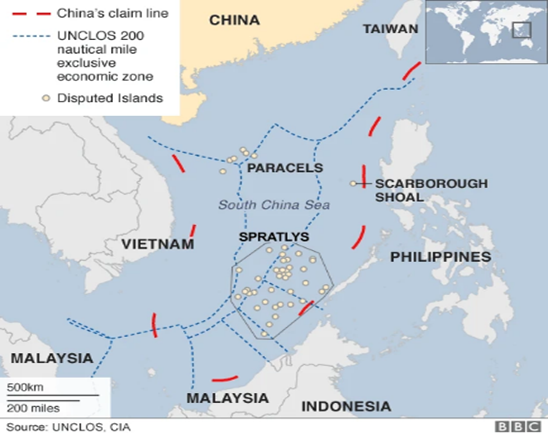
9 dash Line
- China has recently accused the Philippines of intruding into the contested waters near Scarborough Shoal in the South China Sea (SCS).
- The South China Sea is a marginal sea of the western Pacific Ocean, surrounded by Brunei, Malaysia, Indonesia, the Philippines, Singapore, Thailand, Vietnam, and China.
Understanding Scarborough Shoal
- Scarborough Shoal is the largest atoll in the South China Sea, located around 220 kilometers west of the Philippines.
- It lies within the Exclusive Economic Zone (EEZ) of the Philippines, as defined by the United Nations Convention on the Law of the Sea (UNCLOS).
- Despite this, China claims historical ownership, referring to it as part of its ancestral territory marked under the nine-dash line, dating back to the 13th century.
Wider Territorial Disputes in the Region
- The Scarborough Shoal is not the only contested area; the Paracel Islands and Spratly Islands are also part of ongoing maritime disputes in the SCS.
- These overlapping claims have become a source of regional tension, impacting freedom of navigation, resource exploration, and strategic security interests.
BrahMos Missile – A Step Toward Strengthening Defense Ties
India has sent a second batch of BrahMos Missile batteries to the Philippines as part of their growing defense cooperation.
About BrahMos Missile
- BrahMos is a joint venture between India and Russia, designed to develop advanced missile systems.
- It is a long-range supersonic cruise missile capable of being launched from land, sea, and air.
Technical Features
- The BrahMos missile uses a two-stage propulsion system:
- First stage: A solid propellant booster that provides the initial supersonic speed.
- Second stage: A liquid ramjet engine that propels the missile closer to 3 Mach speed during its cruise phase.
- Range: The missile can strike targets at a distance of up to 290 km.
Special Capabilities
- BrahMos is equipped with "Fire and Forget" technology, allowing it to engage targets without needing further guidance after launch.
- Its short flight times lead to reduced target dispersion and enable faster engagement.
- The missile boasts pinpoint accuracy, making it a reliable and effective weapon system.
Comprehensive Remote Sensing Observation on Crop Progress (CROP)
- The CROP system from ISRO has estimated wheat production across India.
- According to CROP, the total wheat production from the eight major wheat-growing states of India is projected to be 122.724 million tonnes by March 31, 2025.
About the CROP System
- CROP is a semi-automated, scalable framework developed by National Remote Sensing Centre (NRSC) under ISRO.
- It facilitates near real-time monitoring of crop sowing and harvesting during the Rabi season across India.
Technology and Tools Used
- The system relies on Optical and Synthetic Aperture Radar (SAR) datasets from multiple satellites, including:
- EOS-04 (RISAT-1A)
- EOS-06 (Oceansat-3)
- Resourcesat-2A
- These data sources help monitor crop conditions during the 2024-25 Rabi season.
Also Read
UPSC Foundation Course
UPSC Monthly Magazine CSAT Foundation Course 

